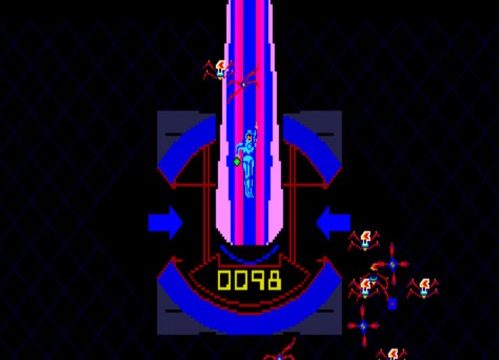The intrepid gillianren remains on hiatus. We’re still happy to fill in for her.
If video games are now (finally!) getting recognized as art, it’s mostly because they’ve begun to resemble other art forms, especially movies. (This may be a general principle.) Video games now have narratives, scenes, cut scenes, music specifically composed for them, characters, and settings; they are expanding beyond that to become immersive experiences and worlds where people spend much of their time. Inception, with its levels and Marion Cotillard as the Final Boss, is one of the definitive video game movies of our time, and it had the great line “the dream has become their reality. Who are we to say otherwise?” which neatly defines the modern video game experience, or at least one terminal of it.
Video games, though, come from a different tradition: the arcade, where the immersion is temporary and meant to be so. The appeal isn’t that of a story, but of the quick adrenaline rush–the fix, really. You drop in a quarter and you don’t give your attention, it gets commanded for some minutes, maybe an hour if you’re really good and obsessive. These games weren’t about world-building, and the best of them worked on simplicity rather than complexity: Space Invaders, Asteroids, Pac-Man, personal favorites Battlezone and the utterly unclassifiable and somewhat unpronounceable Qix. (These videogames were coeval with the first years of personal computing, and the limitations of computer power made this simplicity necessary. I remember the big advances of processing power with games like Robotron 2084.) Disney’s Tron was an attempt to write these kinds of video games (and this kind of video game experience) into a movie, and so of course a game had to be made out of it. (The sequel, Tron: Legacy, with its world-building and characters who take up permanent residence in the game, is much closer to the contemporary video game experience.) It was one of the rare cases where commercial and artistic necessity went together.
Playing it back in 1983, there was a lot to appreciate about the Tron video game and a lot of uniqueness. One unique aspect was incorporating four somewhat different games in one: each game had to be played through to advance to the next level. (Gorf, Scramble, and its successor Super Cobra were good points of comparison, but they were more about moving through different landscapes rather than different games.) Each game was drawn from the movie: the Lightcycle chase (closest to the film), two third-person shooter games where you’re the Tron character, one an aggressive version of Breakout where you have to blast your way through an advancing wall, one (pictured above) where you have to blast through a field of multiplying spiders, and a maze/shooter game where you control a tank. It’s not just that these were visually different, they were strategically different: you had to learn to outlast and shoot all the other tanks in the maze, but the third-person shooter games required you to complete the level as quickly as possible before it became impossible–in the later stages of the game, there were maybe four seconds before that happened.
There was an elegance to Tron, too, that other games lacked. Space Invaders worked on its martial, marching power but was clumsy in its operation. Later games like Missile Command and Centipede/Millipede developed the “trackball,” a little sphere you rolled with your hand to move your on-screen avatar. Tron gave you a trigger joystick (good weight to it, it felt closer to an actual gun than the flimsy-ass plastic ones) and a fully rotating dial (ambidextrous: one to the left and one to the right). One hand moves and fires, the other hand aims: it’s fully physically engaging, you’re playing rather than typing; Battlezone‘s twin vertical-only joysticks are the only better controls I’ve played. The sound was better than a lot of 1983’s games, too, not because of its production (same sound chips) but because of what the designers did with it. The revving glissando of the Lightcycles, the double rhythms of blasting the shields (a mid-range pulse and a higher boink! sound when a shield got hit), and my favorite, Wendy Carlos’ main theme from the movie rendered in glorious 8-bit during the spider attack. It came out as something more mournful and moving than any game had a right to be–the geometric spreading patterns of the spiders were pretty beautiful too.
If these video games weren’t considered art, perhaps that’s because the experience of them wasn’t considered aesthetic. In Microserfs (an excellent, proto-Silicon Valley novel about characters who shared my childhood), Douglas Coupland notes that in these games, “you are gripped. . . .It’s ‘I want to kill this fucker.’ Suspension of disbelief is not an issue.” It’s more athletic than aesthetic. Yet there was such craft in these games, and occasionally, as in Tron, emotion too. Leading us to emotion in places where you wouldn’t expect; that’s one of the things that art does.


